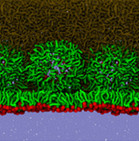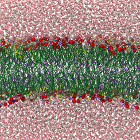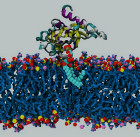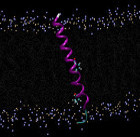What We Do

We try to understand the workings of various processes at biologically relevant interfaces, ranging from the nanoscale to the macroscale, by employing a combination of experimental techniques and computer simulations. We utilize this knowledge to address practical issues such as topical drug delivery and the interaction of implants with the human body.
On the experimental side, we construct simplified wet-lab models of biological interfaces and analyze them using diverse experimental methods. These in vitro bio-mimics enable us to evaluate the macro-scale properties of the systems under controlled conditions. Complementing these experiments, we investigate in silico models of biointerfaces at the molecular level. Specifically, we conduct molecular dynamics simulations to observe the time-dependent behavior of small fragments of biological interfacial systems, consisting of hundreds of thousands of individual chemical molecules. These simulations serve as a 'computational supermicroscope,' allowing us to examine biosystems at the nanometer length-scale and up to the microsecond time-scale. We integrate these approaches to uncover the biophysical molecular-level basis of observed macroscopic phenomena.
Why We Do It

Our goal is to thoroughly understand biological interface systems at the biophysical and chemical levels. Our primary aim is not merely to comprehend nature, but to also apply this knowledge to solve practical problems in pharmacology and medicine. This includes aspects such as drug delivery, the design of biomimetic artificial constructs, and functionalization of implantable material surfaces.
What Systems We Investigate

We study several classes of biologically relevant interfaces, with a main focus on their structure, function, and pharmacological applications.
- First, we are interested in the tear film and the thin layer of lipids that covers the ocular surface of the human eye, known as the Tear Film Lipid Layer. Its primary function is to reduce the surface tension at the tear film/air interface, and deficiencies in this layer can lead to various conditions, such as dry eye disease. This lipid film is also the first structure encountered by drugs in topical ophthalmic products, making its interaction with drug carriers present in eye drops a key area of our research. learn more...
- Second, we examine lipid mono- and multilayers at the water/air boundary, which mimics the human lung surfactant. Our main objectives here are to study the interactions of drugs and air pollutants with these pulmonary interfaces. learn more...

- Third, we investigate the surfaces of polymeric coatings on implantable materials. These coatings form the interface between the implant and the human body and can be functionalized, for example, by being loaded with drugs. We are particularly interested in their interactions with the human body, especially in the context of localized drug delivery. //learn more...
What Methods We Use

In our experimental work, we construct simplified models of the biological systems under investigation (for example, lipid films that emulate the ocular surface lipid film or mimic lung surfactant). We aim to replicate these systems not only by mimicking their composition but also by reproducing essential characteristics such as system geometry, dynamics, and interactions with the environment. In practice, we achieve this by integrating various mesofluidic approaches with microscopic techniques. In our computational work, we conduct simulations, primarily using classical molecular dynamics (MD). We utilize specialized, highly parallelized software and perform these computations on supercomputers located in computational centers. Our software of choice is predominantly GROMACS. Additionally, we engage in quantum chemical calculations both for force field parameterization and for combined quantum-classical simulations. Our coding and scripting work is mainly done using Python. For visualization purposes, we primarily use the VMD code.
Join Us
We are looking for talented people, mainly PhD and master students, to join our lab.
Tear Film Lipid Layer
The Tear Film Lipid Layer (TFLL) is a thin layer of lipids that covers the ocular surface of the human eye. Its primary function is to reduce the surface tension at the tear film/air interface. Additionally, the presence of the TFLL helps prevent the rapid evaporation of water from the underlying aqueous phase. Deficiencies in the TFLL can lead to evaporative dry eye syndrome, a commonly reported eye ailment. Despite its critical role in eye function, the structure and other properties of the TFLL at the molecular level are largely unknown. We construct and use experimental mesofluidic models of the TFLL to investigate the structure and dynamics of this interfacial system and its interactions with topical ophthalmic drug carriers. With this knowledge, we also aim to optimize these carriers for their interactions with the tear film. On the computational side, our group was the first to propose a realistic in silico model of the TFLL. We use this model to study drug-TFLL interactions at the molecular level. Our big goal is to contribute to the knowledge-based development of new ophthalmic drug carriers.
Pulmonary Surfactant
Pulmonary surfactant is a complex, multilayered lipid and protein film that covers the surface of alveoli in human lungs. This interfacial structure serves as the first line of defense between the air and the organism and is susceptible to damage by environmental factors such as free radicals and air pollutants. Additionally, this barrier is relatively permeable and may serve as an effective drug delivery pathway. In our experiments, we mimic the pulmonary surfactant using lipid and lipid-protein multilayered films at the air-water interface, and we further explore these systems through molecular simulations. We study them in the context of drug delivery as well as their interactions with air pollutants, such as nanoplastics.
Polymeric Coatings of Medical Implants
Implantable medical materials such as pacemakers, contact lenses, or continuous glucose monitoring devices are often coated with thin polymeric films. These films form the interface between the body and the implant. These polymers can be relatively easily modified, for instance, to enhance their biocompatibility or to prevent bacterial adhesion. Importantly, they can also be loaded with drugs, such as anti-inflammatory agents, cytostatics, or antibiotics. We study such polymeric interfaces in the context of their biocompatibility and drug delivery potential. To this end, we combine several surface science experimental methods with molecular simulations. For instance, we have developed a realistic in silico model of functionalized polyurethane coatings and use it in tandem with experiments to investigate the drug delivery capabilities of polyurethane film surfaces.